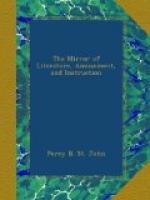* * * * *
NUMISMATICS.
[Addison, in commenting on the Usefulness of Ancient Medals, says, “A series of an Emperor’s Coins is his life digested into Annals.” Who shall, therefore, gainsay the the utility of A Numismatic Manual, or Guide to the Study of Coins. The author, Mr. John Y. Akerman, does not intend his volume exclusively for the use of the experienced medallist, so that much popular interest may be expected in its pages. The title bespeaks its contents, but we quote a few brief extracts relating to rare English coins.]
Ecclesiastic Money.—This money was coined by prelates prior to the Norman Conquest. Of these there are pennies of Jaenbearht, archbishop of Canterbury, with the reverse of Offa, king of Mercia, Aethileard, Wulfred, Ceolnoth, Plegmund, and Ethered. They are all extremely rare, excepting those of Ceolnoth, which are not so rare as the others. Besides these there are pennies of St. Martin, coined at Lincoln, and St. Peter’s pennies, struck at York, which are supposed to be as old as the time of the Heptarchy. Those of St. Edmund, coined at Bury, are prior to the Norman Conquest. The pennies of St. Paul are, it would seem, by the cross and pellets on the reverse, not older than the reign of Henry III.
All Stephen’s money is very scarce, and one or two types are exceedingly rare. At a sale in London, in 1827, the penny of Stephen with the horseman’s mace, brought thirteen pounds. His coins are generally very rude and illegible. This king coined pennies only.
The groat of Edward I. is of the first rarity.[10] The pennies of Hadleigh, Chester, and Kingston, are scarce; the other pennies are extremely common, and scarcely a year passes without a discovery of new hoards. The half-pennies and farthings are somewhat scarce. From this time to the reign of Henry VII., the English coins bear a great resemblance to each other.




